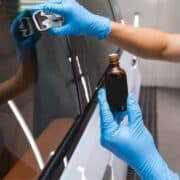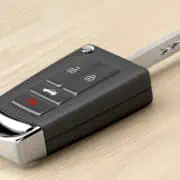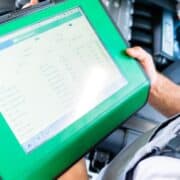
We’ve all felt a strong desire to squeeze out every bit of performance from our car.
But not everyone has the time or technical knowledge to swap out engine parts or install complex modifiers. Thankfully, you don’t need to go that far. You can get started with a good car tuning laptop, a tuning software program, and a few other tools.
Keep reading to find out how to tune a car with a laptop with actionable steps to carry out the process yourself.
Things To Keep In Mind When Tuning Your Car With a Laptop
There are a few things to consider before tuning your car with a laptop. Here are some of them:
You Can Only Make Small Tweaks
Simply connecting a laptop to your car doesn’t make you a master tuner. And changing a few settings won’t give you an F1 car or Corolla-like fuel economy.
If you’re reading this, you’re probably not a tuner with cutting-edge tools and diagnostic equipment like a dyno or rolling road to properly test your car or any modifications you make. These tools aren’t necessary for tuning but will help you better keep track of things and get slightly better results.
Just take your time and tweak for slight but meaningful gains.
You Need a Reliable Laptop
You don’t want your laptop to crash in the middle of a session, so forget tuning a car with an old malfunctioning PC.
Aside from a powerful processor that can handle any tuning software, you need to connect the laptop to the OBD port on your car via USB-C or HDMI. Thankfully you can get a dongle if your laptop doesn’t have the necessary ports.
While it’s not a dealbreaker, a bright, clear screen does wonders for outdoor tuning.
Software Makes All the Difference
You need the right software to go with your laptop.
Some programs support specific car brands and models, countries, and operating systems. Check out the support lists of some popular car tuning software, including HPTuners, Toad Pro OBD1 and OBD2, Viezu K-Suite, and ECUTek ProECU.
You can also check our review of the best tuning software programs.
How to Tune a Car With a Laptop
When tuning, the first thing to do is install an engine control unit (ECU) program compatible with your car. Then, connect your laptop to the car engine via the OBD port.
Next, accelerate on a dynamometer or traffic-less road to monitor the car’s performance and tweak the software values to your taste. After tweaking, accelerate on the dyno again to see if the performance has improved.
Repeat until you find the optimal values for your car. Allow the car to cool down between tweaks so you get accurate readings. This is a general approach to tuning.
Here’s a more specific tuning guide using the ECU+ Win program:
Step 1: Install the ECU+ Win Software
Get a good tuning laptop, and install and launch the ECU+ Win software.
Step 2: Request Support From a Friend
You should have someone else with you while tuning to operate the laptop while you drive.
Step 3: Find a Smooth and Empty Road (or a Dynamometer)
If you don’t have access to a dynamometer, choose a smooth, empty, flat road with a 50–60 mph speed limit to test the car.
Choose a route without residential areas since you’ll be running at full speed—a drag strip should do fine, especially at night when the road is unlikely to be busy.
Step 4: Choose a Start Point and Begin ECU+ Capture
Use a mile-maker or a street sign as your starting point.
Your friend should start the ECU+ capture (datalog) as you fully throttle your car in second gear. Keep your vehicle at a low RPM (revolutions per minute), and note the RPM as you drive. Once you’ve passed the starting line, floor the accelerator and raise it to redline before coasting back down.
Instruct your buddy to stop and save the capture as you come to a halt and park.
Step 5: Get Consistent HP and Torque Numbers
Repeat the previous step about three to four times until the torque and horsepower readings are consistent.
Remember to let the car cool down between captures. Use the software’s overlay function to plot and see multiple graphs.
Step 6: Tweak a Few Things
Once you have consistent results, change one or two settings at a time and test after each change.
Check to see if your car has more or less horsepower with the adjusted parameters and make further adjustments.
Step 7: Adjust Your Car for Maximum HP and Torque
Repeat the previous step several times to produce the most torque and horsepower while also looking at delayed timing, detonation, and lean mixture in the captures.
Consult the software manual to see what other components you can modify.
Areas To Consider When Tuning Your Car With a Laptop
Here are some of the key aspects to consider when tuning your car with a laptop:
Gearbox and Transmission
Gearbox and transmission upgrades are very popular. It includes reducing the gap between gear changes and other tweaks to boost your car’s performance.
Exhaust and Intake Systems
You can improve the cold air intake by adding new parts, such as dual exhausts, to boost horsepower.
Fuel System
The fuel system and ignition timing are areas to consider when tuning. But watch out for blocked or broken pipes that dramatically lower the car’s performance.
Suspension
Investing anti-roll bars, springs, and shock absorbers during tuning can improve a car’s performance on bumpy roads.
Pre-Tuning Inspection
Pre-tuning inspection is necessary to improve performance. It involves checking the car’s fundamentals like gasoline and oil levels and examining other dynamics that can interfere with testing and prolong the process.
Tools Required to Tune Your Car
You’ll need a few tools to tune your car with your computer. The most important ones are listed below and can be gotten from a hardware or online performance parts store:
Laptop
It goes without saying, but you need a laptop to to tune your car with a laptop.
The laptop should have a powerful enough processor to run the vehicle tuning program you’ll use, alongside sufficient RAM, supported ports like USB-C and HDMI, and a bright display for outdoor use.
We’ve reviewed some of the best car tuning laptops here.
Software
If you already have an ECU reflashing kit or piggyback, you’ll likely find a software package included with it.
However, if the reflashing tool doesn’t come with any software or you don’t have a tool, you can find a good software online. Ensure it’s compatible with your car before buying it.
Most apps perform other functions alongside tuning your car. For example, Toad Pro OBD analyzes your car’s health and identifies frequent issues alongside modifying the ECU to improve performance and fuel economy.
ECU Reflashing Tool
Tuning your car modifies the ECU to allow you tap into the extra power that the manufacturer restricts.
The ECU is an electronic device that reads data from sensors in the engine bay and analyses it using performance maps. It then modifies the engine’s actuators in response to the findings.
Within the ECU is a memory that holds the programming to control the running of your engine called electrically erasable programmable read-only memory (EEPROM). It prevents unauthorized changes from being made to the ECU.
Some people entirely swap out the original ECU. However, an ECU reflashing tool (or ECU piggyback) can help you get around this by replacing the engine control map in the EEPROM. This new map will change how your car reacts to sensor readings, allowing you to get more out of your vehicle.
There are numerous ECU reflashing tools. But they are not universal, so ensure you get one that’s compatible with your vehicle.
Car Dynamometer
The performance of your car should be tested on a dynamometer (or dyno) to prevent the risks associated with testing it on the road.
It helps to measure your car’s torque, rotational speed, and top speed without the dangers of road testing like getting a penalty or worse. You probably won’t be able to buy one yourself because they cost tens of thousands of dollars, but you can rent one.
Dynos are usually available for rent on a per-hour basis in several locations in the US.
Gauges
You’ll need a ton of gauges in good working order when tuning your car to ensure everything goes smoothly.
Wideband O2 meters, exhaust gas temperature gauges, and oil pressure gauges are a few examples of gauges you may need while tuning your car.
Patience Is Key When Tuning Your Car
Tuning is not something you rush, especially if you’re getting into it for the first time.
You need to take things slowly, change few parameters at a time, and test extensively as you go. This helps you keep track of what you’re doing and lets you retrace your steps if something goes wrong.
FAQs
Will Tuning My Car With a Laptop Void Its Warranty?
Yes. Tuning your car with a laptop will void its warranty. OEM warranties state that unapproved modifications to any car components void their warranty. Tuning requires changing the ECU’s factory settings or uploading a new update into the ECU, which is not supported by most OEMs.
Can I Increase the Speed of My Car With Tuning?
Yes. You can increase the speed of your car with tuning. A successful tune can increase your horsepower by 10–15 percent for a stock car without performance parts. If you’ve upgraded your car with performance components like a turbocharger, cold air intake, or exhaust, you can get horsepower bumps as much as 50%.
Can You Tune Your Car With a Laptop?
Yes, you can tune your car with a laptop and a few essential tools. You can also go to a tuning shop and hire a professional to do it.
Can You Tune a Stock ECU With a Laptop?
Yes, you can tune a stock ECU with a laptop, tuning software, and a few other tools. You can get improved performance and fuel efficiency from the process.
How Do I Connect My Laptop to My Car ECU?
You can connect your laptop to your car ECU via the diagnostic socket. It’s usually about 1 meter from the steering wheel. Connect the USB end of the interface cable to your laptop’s USB port and the vehicle connection end to the diagnostic jack.










